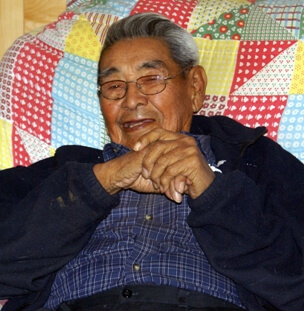
Reverend Chief Dr. David Salmon explains from his recliner in Chalkyitsik, Alaska on a beautiful fall day in September. Gorgeous outdoors, David, First Traditional Chief for the Athabascan people of Interior Alaska, sat in a toasty warm room with his white dog at his feet. Several bibles sit in front of him, two adorned with beadwork and full moose skin covers. By Indian standards, he is affluent–beadwork adorns his cabin walls and tables.
Twice his father took David away from the community; first in 1923 to avoid the devastating epidemic of tuberculosis, which fell upon the Alaska Native community and furiously wiped out an entire generation. He and his father spent two and a half months in the wilderness, trapping furs to survive after his mother succumbed to TB.
The second time David’s father took him away was while he was in Fort Yukon. He attended mission school for one year from 1924-25; this time represents the total sum of his formal education and speaks volumes about his ability and dedication to knowledge. “Education is number one! Today the Indians who don’t use their education are walking the streets; that’s what I don’t like. Education [is] gonna get all the land, education [is] gonna get all the business. You don’t see Indians owning a lot of land in Fairbanks, owning a lot of businesses. Indians got to get [an] education!”
David’s father took him 80 miles up the Grayling River, beyond the Black River, to a camp in “No Man’s Land” as his father referred to it. There he was taught the history of his people, about Indian migration, stories, and a way of life that no longer exists for the present Indian. There he spent 18 years, at one point bringing back his new wife for the remaining ten years.
In the spring of 1941, David and his family determined to build up the community of Chalkyitsik. They built the school by hand, “we brought the logs from upriver…I know my tribe, I’m a slave Indian [not a land owner but rather a ‘servant’ of the people]. My wife was a Best Indian” describing her class as elevated from his: landowners with property rights of the area and a politically rich personage. He refers to himself many times as a servant, an oxymoron of types considering the expansive title before his name. He is quick to laugh and quicker to tease. Immediately one wants to spoil David, bring him water or something to eat. His demeanor is quiet and peaceful, conscientious toward the strong belief he carries of “God first.” While steadfast in his faith to God, David regards Indian Law and Leadership two strong components in the success of Native people. He determines the social ills we face today as a direct result of ignoring the two.
At the age of 95, David remains quite active. He holds bible study in his cabin everyday, which explains the long meeting table in the middle of his living room. Sitting atop the tablecloth is a simple birch bark basket that reads “revival donation” and there are one dollar bills quietly asking for company.
He can quickly tell you of his October travel plans, Anchorage and Fairbanks being a part. He will address the delegation of the 2007 Alaska Federation of Natives Convention held October 22-27 in Fairbanks. Ultimately, David is the epitome of their theme, “Living Cultures in the North.” Never underestimate the image of this man who walks with a cane and slow gate. His strength, his past, and his legacy are never far behind.
